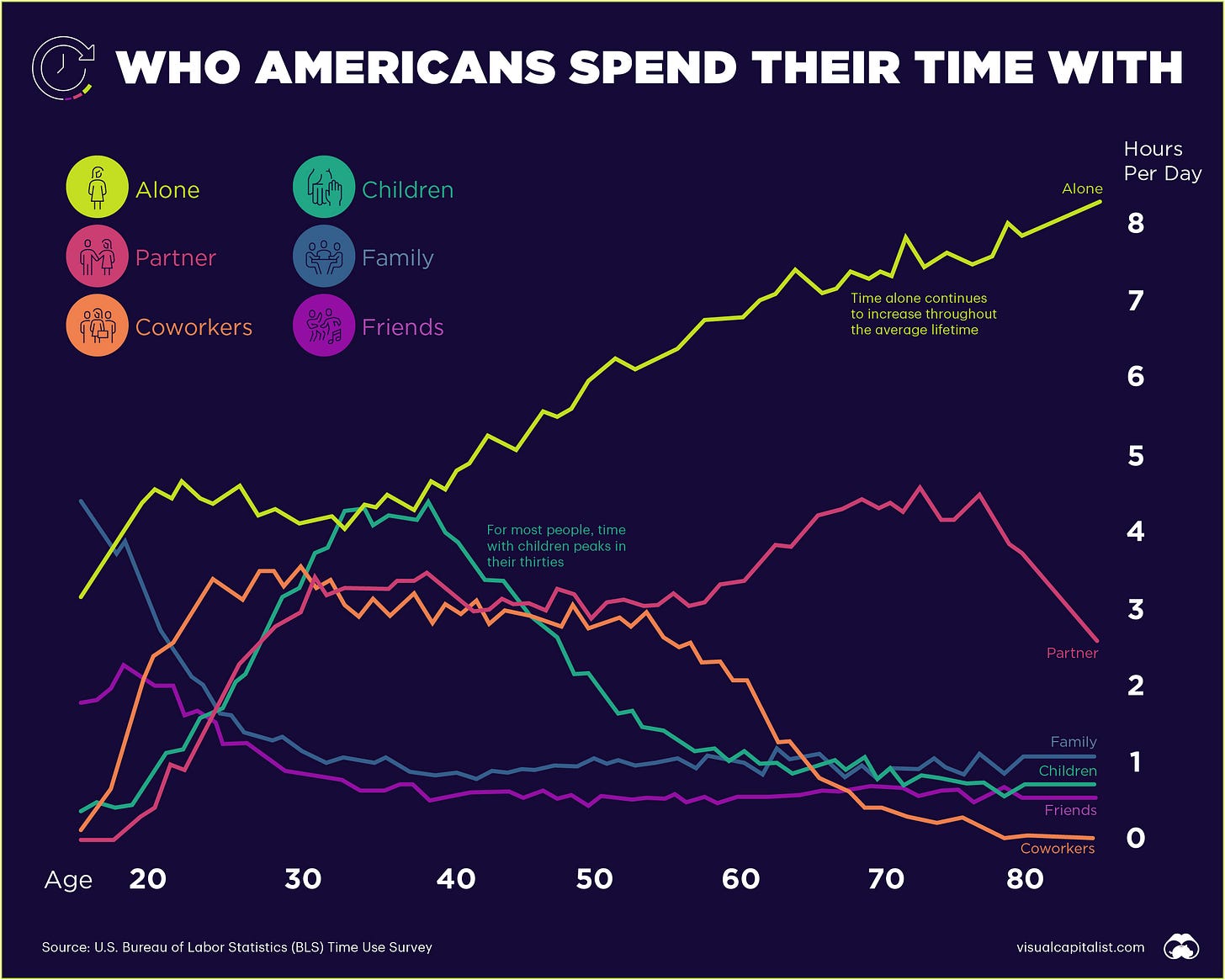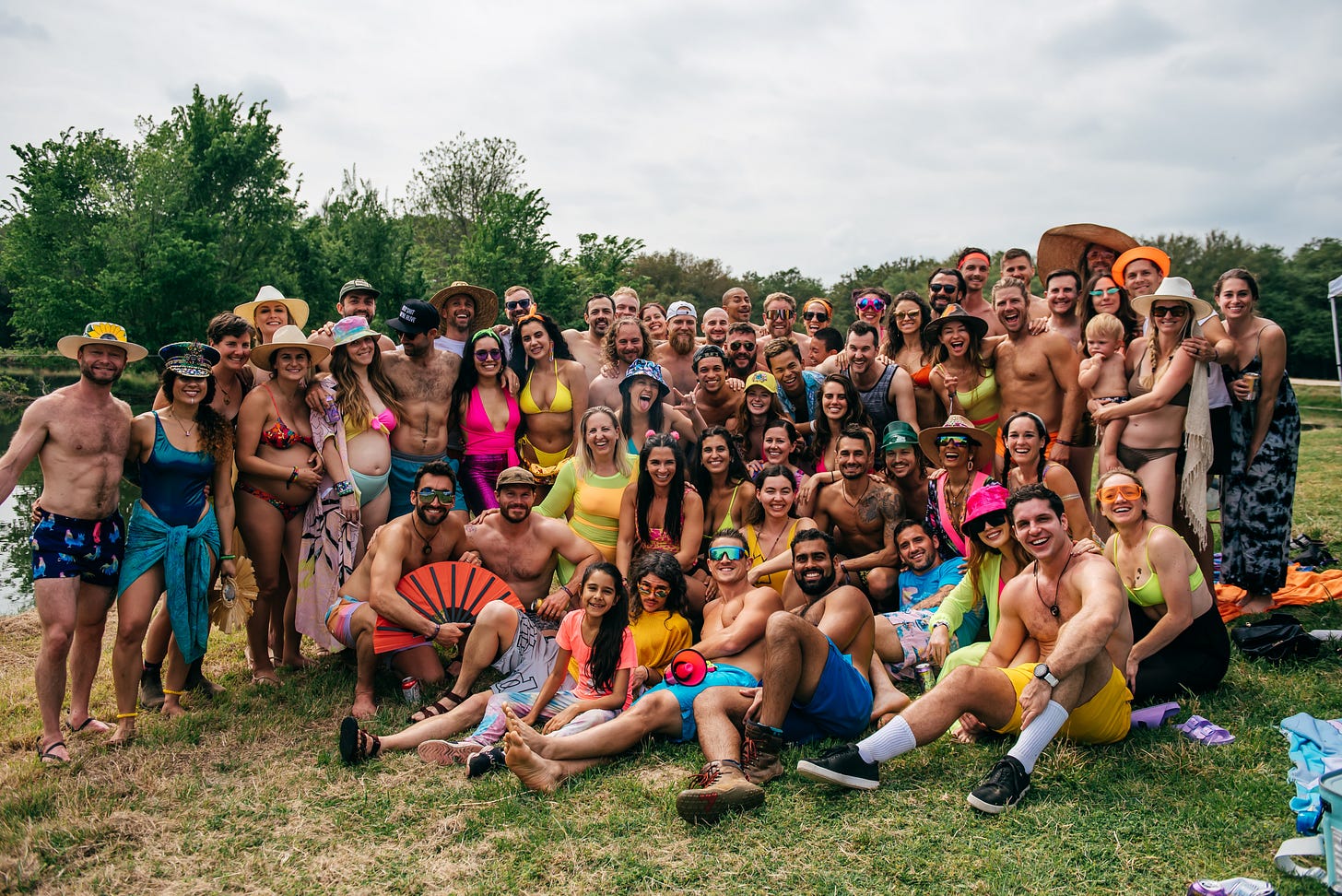Convertible top down, music blaring, surrounded by friends, no place to be or go— just pure, exhilarating freedom. It’s the classic Americana memory of youth and one that I cherish. A window back to the raw enjoyment I felt when I lived a much more carefree life surrounded by friends.
When the halcyon days of college ended, and I transitioned to the 'real world,' life took a predictable turn. The hours of carefree time between classes, spontaneous group adventures, BBQs, parties, and road trips were replaced with phone calls, work travel, spreadsheets, and computer time.

From carefree to care-full
After leaving college, the ease of spending countless hours with friends received its first gut punch. Consistent close proximity and abundant free time made creating deep friendships much more accessible.
Close proximity and minutes spent together are the raw ingredients for friendship magic. It’s a compounding effect of the small moments; the meals shared, the conversations had, and the quiet moments where the foundation of the relationship is formed. Then, sprinkle in a handful of those magic moments, like the rush of excitement leaving for a new adventure or sharing a significant milestone, and you get the makings of lifelong friends. Friends who become more like family.
The abrupt removal of carefree time makes relationships post-those youthful years more challenging to make, keep, and deepen. The responsibilities of adulthood soak up the extra time previously devoted to friendship.
However, it’s not just our friends we typically spend less time with as we age. It’s most everyone we know. This chart floats around the internet every so often. For many, including me, it’s a wake-up call to notice how precious our time on Earth is.
Who we spend our time with and how much we spend with them changes as we age. That much becomes obvious as soon as we begin paying our own bills.
The standard American life
Sadly, however, time spent alone makes a relentless march higher as we age. A depressing function of the way our culture orients around life, work, and family. Gone are intergenerational households, extended family down the street, and intimate neighborhoods grounded around third spaces. Instead, we get beautiful lawns, big houses, and lots of driving.
This suburbanization creates a dynamic where time spent with friends and family peaks in the late teens. After graduating college and moving to Atlanta, visiting a friend after work on a weekend meant up to a 45-minute drive to go three miles. And, because relationships require proximity (physical or digital) and raw minutes spent together, forming and deepening bonds with new characters that enter our life becomes more and more difficult.
Today many conversations with friends and acquaintances still end up with us getting our calendars out and realizing the only shared time we have available to spend even 2-3 hours together is three months in the future. Ouch…
Many of the best parts of youth get lost as we age, the novelty and wonder, the naivety and blunder, but, in particular, I mourn losing that abundance of time spent with friends and family.
Hey, at least I have my kids to spend time with, right?
Well, as a soon-to-be dad, it’s a wake-up call to see that the average American only gets around 8-10 years of peak time with their kids. That does not feel like a long time at all (or, if they’re toddlers, maybe it’s way too much time! I’ll check back in a few years).
But, I look at this and wonder:
1) Does it have to be this way?
2) What can I do to orient my life so I get to spend more time with the people I love?
I look at that graph and see what I don’t want. If the average American lifestyle means more time spent alone each and every year, with less time spent in the company of those I love most, count me out.
It’s another reminder that I must fight against the momentum of the “Standard American Life,” a life that, from my observations at least, leads to more loneliness and poor health.
Maximize what matters
Since close proximity and minutes spent together are the raw ingredients necessary for deep relationships, maximizing the experience of those has become a strong priority for my wife, Taylor, and me. To do that, we’re experimenting with maintaining close proximity to our loved ones as we grow, raise families, and age. We want to bend that curve of friendship, family, and kids upward as we age, not let it meander down and to the right.
For the friendship piece, I’ve done different projects with ten close friends over the last three years to test this hypothesis. In 2021 we planned, hosted, and ran a micro-festival for around 60 people on our friend’s ranch. We spent weeks and no less than 100 hours working on this project. In 2022, we did the same but made the festival even bigger.
We spent a lot of time in proximity to each other but not just hanging out, catching up, playing games, or gossiping. We were working together, collaborating on a vision, building something. It was a different way to spend time with friends, and we all loved it (especially when it was over, not so much in the run-up to the event when the panic was setting in!)
Then throughout 2022 and 2023, we planned a new experiment. How would it feel to spend extended time together in the same house? And, because we don’t want to do things the easy way, what if we also hosted a 25-person retreat while there to test further our problem-solving, teamwork, collaboration, and relationships? We worked for around ten months on the retreat meeting every other week for 1 hour and then meeting weekly for the last four months.
Our dream is to live within walking distance from our friends on a gorgeous piece of land. There’s a lot of risk involved, both monetary and relationship risks. Designing MVPs (as we’re calling them) to test our bonds, feel what it’s like to work together on projects, and build something has already brought us closer to this vision. We’ve ended up already bending our friendship curve a lot higher.
If you’re interested, your version of this doesn’t need to be as intense as planning a festival or international retreat. Something as simple as a standing family dinner, game night, or monthly book club can help you maintain and deepen relationships. Weekly video calls with a friend living in a different city or regular trips to visit out-of-town family members can do wonders too.
My point is proximity and time spent together are the lifeblood of maintaining and deepening relationships, but they don’t have to be spontaneous. As we grow older and life gets more complicated, spontaneity becomes a negative for maintaining bonds.
Much of this gets solved if we all live closer to our friends. We would bring that carefree serendipity from our youth back into life. Many of the realities of aging can be inescapable. Raising a family takes an enormous amount of focused dedication and time. However, making time spent with family, friends, and kids more accessible and predictable is well within our abilities.
-Jared







That chart = no bueno!